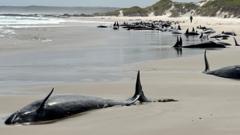More than 150 false killer whales stranded on a remote Tasmanian beach are facing euthanasia following a tragic event that highlights ongoing concerns about marine life and conservation. The whales beached near Arthur River, in the island's northwestern region, with reports indicating that about 90 of the 157 animals were still alive as of Wednesday.
Tasmania's Department of Natural Resources and Environment confirmed that, despite the presence of juveniles within the pod, complex conditions surrounding the site rendered rescue efforts nearly impossible. It’s notable that although there have been several mass strandings in Tasmania over the past few years, this marks the first occurrence of false killer whales stranding in over half a century.
False killer whales are classified as one of the largest species of dolphins and can weigh up to 1.5 tonnes and measure around 6 meters (19 feet) in length. With the whales stranding for 24 to 48 hours already, expert teams evaluated the situation but faced immense challenges in accessing the location due to rough terrain. Local resident Jocelyn Flint expressed her distress after witnessing the stranded whales and their calves, calling the situation “absolutely horrific.”
Despite efforts to refloat some of the surviving whales, the conditions proved too difficult as they kept returning to the beach instead of heading back to the ocean. As expert wildlife veterinarians assessed that the prolonged stranding resulted in significant suffering for the whales, they made the agonizing choice to euthanize the remaining animals—a decision that Dr. Kris Carlyon noted was a last resort.
Plans for the ongoing euthanasia effort are expected to continue amid considerations for management and disposal of the carcasses, particularly given the site's cultural significance to local Aboriginal communities. Officials have requested the public to avoid the site due to nearby bushfires and the challenging road access.
Significantly, over 80% of whale strandings in Australia occur in Tasmania, frequently on its west coast. The situation raises broader questions about the factors contributing to these mass strandings, with theories suggesting disorientation from hunting fish or an individual whale leading the group astray.
As communities reflect on the fate of these whales, the issue of marine life conservation continues to be at the forefront of discussions, highlighting the relationship between humans and the environment.




















